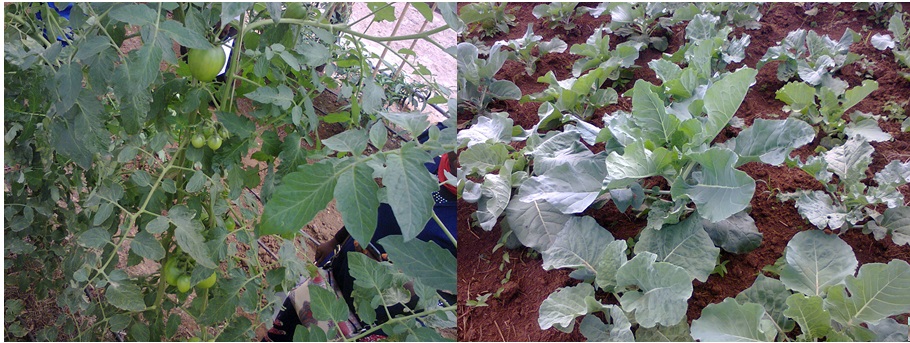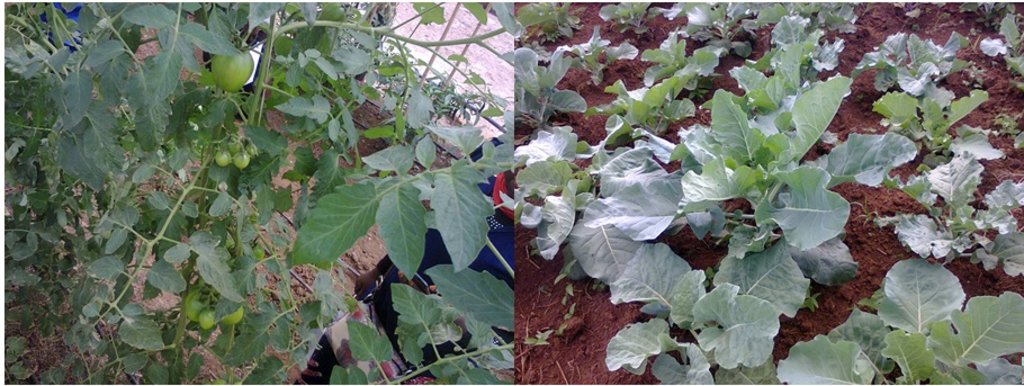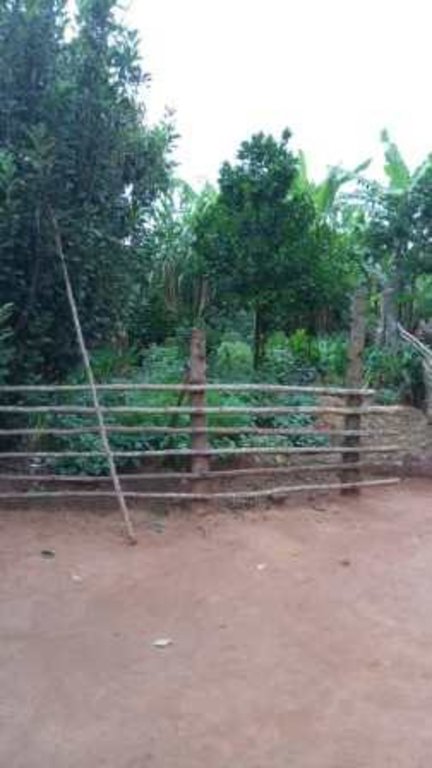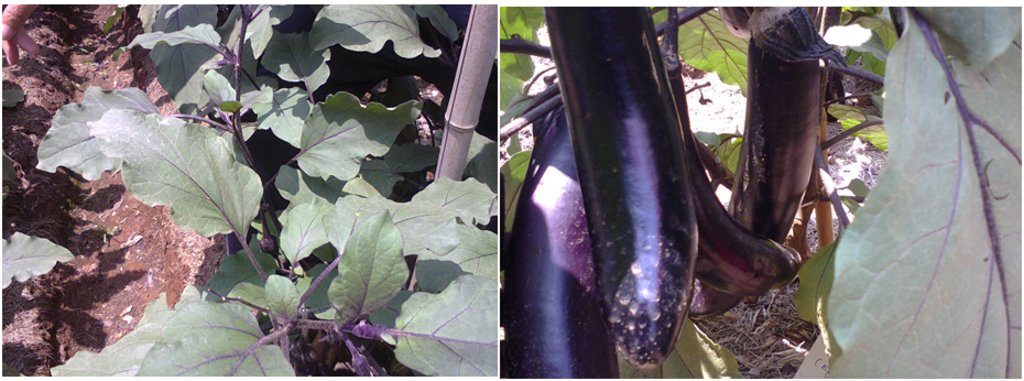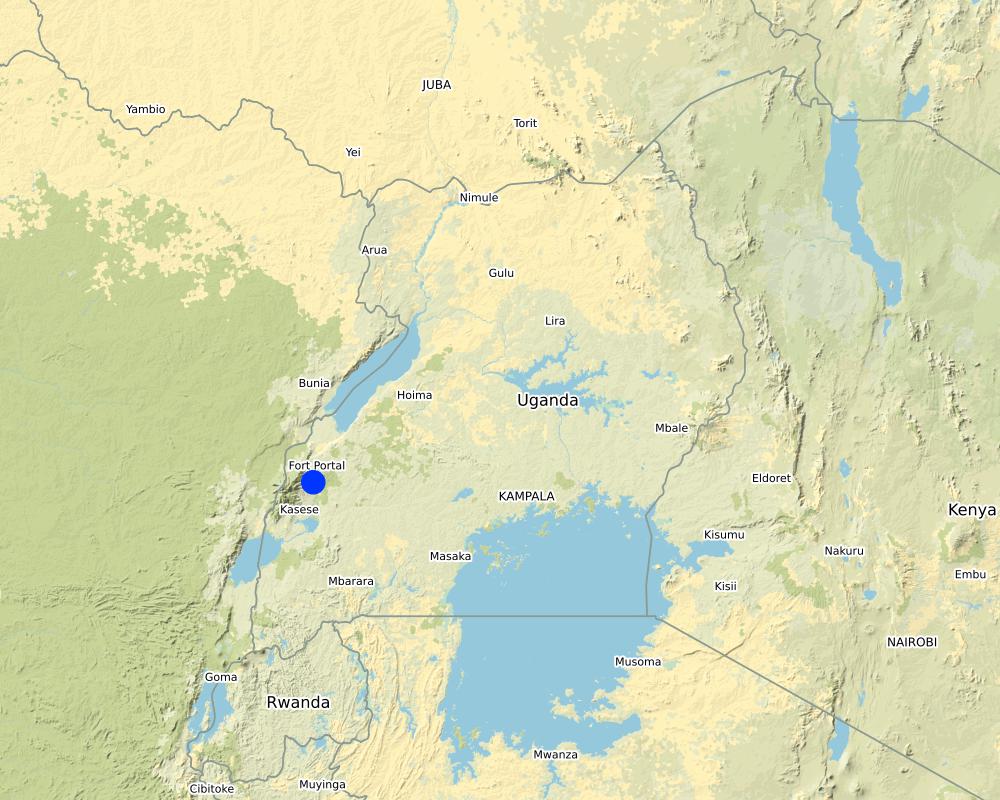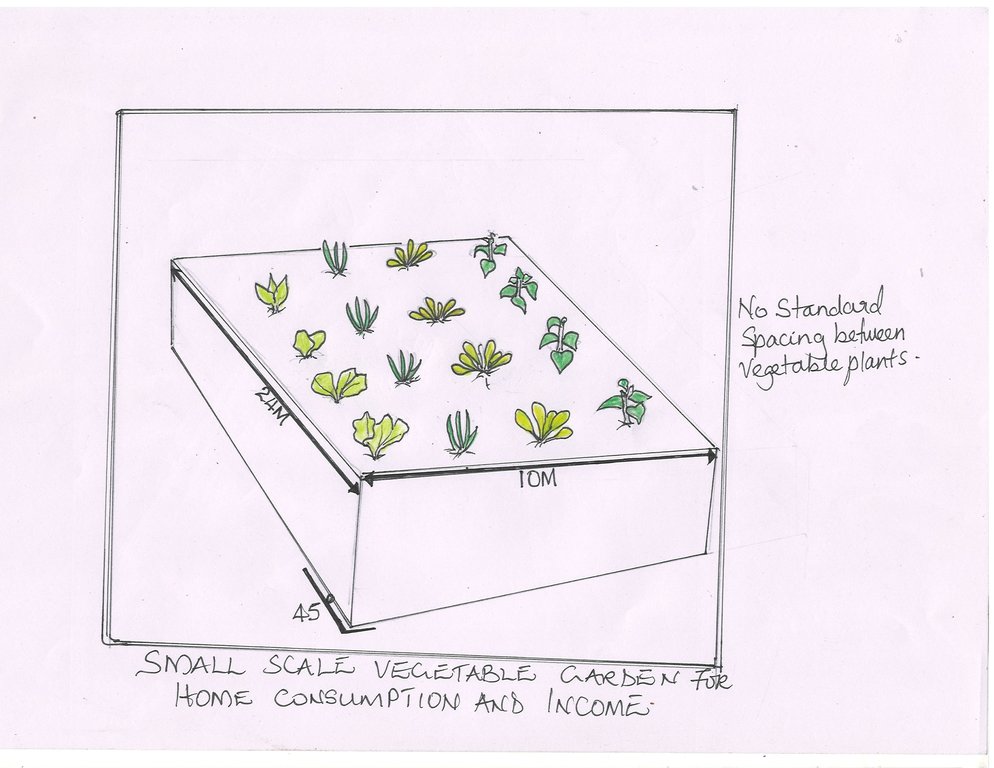Small Scale Vegetable Garden for Home Consumption and Income [乌干达]
- 创建:
- 更新:
- 编制者: PRISCILLA VIVIAN KYOSABA
- 编辑者: Kamugisha Rick Nelson
- 审查者: Nicole Harari, Udo Höggel
Obusiri bukye bwemboga bwokuriisa eka ahamwe nokuguza
technologies_3484 - 乌干达
查看章节
全部展开 全部收起1. 一般信息
1.2 参与该技术评估和文件编制的资源人员和机构的联系方式
关键资源人
土地使用者:
Margaret Baguma
Kabarole District Local Government
Kabarole District, Western Uganda
乌干达
有助于对技术进行记录/评估的项目名称(如相关)
Scaling-up SLM practices by smallholder farmers (IFAD)有助于对技术进行记录/评估的机构名称(如相关)
National Agricultural Research Organisation (NARO) - 乌干达1.3 关于使用通过WOCAT记录的数据的条件
(现场)数据是什么时候汇编的?:
20/05/2017
编制者和关键资源人员接受有关使用通过WOCAT记录数据的条件。:
是
1.4 所述技术的可持续性声明
这里所描述的技术在土地退化方面是否存在问题,导致无法被认为是一种可持续的土地管理技术?:
否
2. SLM技术的说明
2.1 技术简介
技术定义:
A vegetable garden (also known as a vegetable patch or vegetable plot) is a technology promoted by small and medium scale farmers in Western Uganda to grow vegetables and other plants namely spinach, egg plants, sukuma wiki, onions and tomatoes for human consumption and income usually established in backyards.
2.2 技术的详细说明
说明:
The vegetable varieties grown are egg plants, spinach, sukuma wiki, tomatoes, and amaranths for human consumption, income and soil fertility improvement. It is a small-scale form of vegetable growing that includes a compost heap, and several plots or divided areas of land intended to grow one or more types of plants in each plot. Plots may also be divided into rows with an assortment of vegetables grown in those different rows. It is usually located in back gardens.
This practice can be carried out by anyone willing to invest some time every day to nurture the plants. It doesn’t take a lot of money or time. Backyard gardening provides fresh and nutritious fruits and vegetables having a higher nutrient content than vegetables that have traveled several hundreds of miles to markets. The technology uses family labour which is readily available and relatively cheap compared to hired labour.
The activities involved in establishing such a technology include (1) clearing area where vegetables will be grown, (2) buying seed (3) weeding (4) acquiring pesticides, if required to spray the garden. Scarcity of water during the dry season may affect production while litter from plant material can increase productivity in the short run.
Inputs required for establishing such a technology include: labour, seed, hoes and panga. With this technology a farmer reported establishing the garden on an area size of 10 x 24 meters. Various vegetable varieties were planted in different specified plots. The farmer reported to have used UGX 208,100/= two hundred eight thousand one hundred shillings only.
Vegetable gardening is becoming more popular both as a part time job and as a source of income. One of the most important aspects needed for this practice is water, which makes up 90 percent of a plant’s weight. However, watering is a heavy and difficult job so the farmer established her garden near her house in the compound making access and watering easier.
Home gardening offers an opportunity to reduce the amount of pesticides used because plant and pest control can be tighter close to homesteads. Gardening increases physical activity. It is a great way to engage the whole family in physical activity and take responsibility for the garden. Vegetables grown in homegardens will promote health because they are rich in nutrients, especially in phytochemicals, anti-oxidants, vitamin C plus A and foliate.
2.3 技术照片
2.4 技术视频
日期:
17/11/2017
位置:
Bushenyi District, Western Uganda
摄影师的名字:
Aine Amon
2.5 已应用该技术的、本评估所涵盖的国家/地区/地点
国家:
乌干达
区域/州/省:
Western Region
有关地点的进一步说明:
Bushenyi District
Map
×2.6 实施日期
如果不知道确切的年份,请说明大概的日期:
- 不到10年前(最近)
2.7 技术介绍
详细说明该技术是如何引入的:
- 作为传统系统的一部分(> 50 年)
3. SLM技术的分类
3.1 该技术的主要目的
- 创造有益的经济影响
3.2 应用该技术的当前土地利用类型

农田
- 多年一作(非木材)
主要农作物(经济作物及粮食作物):
Vegetable crops grown and harvested every after two weeks.
3.3 有关土地利用的更多信息
该技术所应用土地的供水:
- 混合雨水灌溉
每年的生长季节数:
- 3
3.4 该技术所属的SLM组
- 家庭花园
- Horticulture
3.5 技术传播
具体说明该技术的分布:
- 适用于特定场所/集中在较小区域
3.6 包含该技术的可持续土地管理措施

农艺措施
- A2:有机质/土壤肥力
3.7 该技术强调的主要土地退化类型

生物性退化
- Bc:植被覆盖的减少
3.8 防止、减少或恢复土地退化
具体数量名该技术与土地退化有关的目标:
- 不适用
4. 技术规范、实施活动、投入和成本
4.1 该技术的技术图纸
4.2 技术规范/技术图纸说明
Size of the vegetable garden is 10 by 24 meters. There is no standard spacing between the vegetable plants grown. Some 5 hybrid varieties of vegetables are gown mostly in settlement backyards.
4.3 有关投入和成本计算的一般信息
具体说明成本和投入是如何计算的:
- 每个技术区域
注明尺寸和面积单位:
Garden area is 10 * 24 meters
注明美元与当地货币的汇率(如相关):1美元=:
3650.0
注明雇用劳工的每日平均工资成本:
10000
4.4 技术建立活动
| 活动 | 措施类型 | 时间 | |
|---|---|---|---|
| 1. | Buying seeda and planting the vegetable seeds nursery bed | 管理 | Once |
| 2. | Clearing the area where the garden will be established | 农业学的 | once |
| 3. | Applying manure to designated garden area | 植物性的 | Every after a month |
| 4. | Transplanting the seedling from seed bed to the main garden | 农业学的 | After two weeks |
| 5. | Watering | 管理 | Daily |
| 6. | Spraying the plants | 管理 | After two weeks |
| 7. | Weeding the vegetable garden | 管理 | After two weeks |
注释:
Above mentioned activities are stated as reported by farmer.
4.5 技术建立所需要的费用和投入
| 对投入进行具体说明 | 单位 | 数量 | 单位成本 | 每项投入的总成本 | 土地使用者承担的成本% | |
|---|---|---|---|---|---|---|
| 劳动力 | Clearing garden area | person-days | 2.0 | 3200.0 | 6400.0 | 100.0 |
| 劳动力 | Applying manure | person-days | 1.0 | 5000.0 | 5000.0 | 100.0 |
| 劳动力 | Transplanting seedling | person-days | 2.0 | 10000.0 | 20000.0 | 100.0 |
| 设备 | Watering the plants | person-days | 32.0 | 2000.0 | 64000.0 | 100.0 |
| 设备 | Spraying | person-days | 24.0 | 3600.0 | 86400.0 | 100.0 |
| 设备 | Weeding | person-days | 3.0 | 3600.0 | 10800.0 | 100.0 |
| 植物材料 | Buying Seeds | Pieces | 5.0 | 3100.0 | 15500.0 | 100.0 |
| 技术建立所需总成本 | 208100.0 | |||||
注释:
The estimation cost stated above was given by farmer.
4.6 维护/经常性活动
| 活动 | 措施类型 | 时间/频率 | |
|---|---|---|---|
| 1. | Spraying the vegetable garden with pesticides | 植物性的 | Every after two weeks |
| 2. | Applying manure | 管理 | Every after a month |
4.7 维护/经常性活动所需要的费用和投入(每年)
| 对投入进行具体说明 | 单位 | 数量 | 单位成本 | 每项投入的总成本 | 土地使用者承担的成本% | |
|---|---|---|---|---|---|---|
| 劳动力 | Application of manure and pesticides | person-day | 3.0 | 3200.0 | 9600.0 | 100.0 |
| 肥料和杀菌剂 | Pesticides | Litres | 5.0 | 6000.0 | 30000.0 | 100.0 |
| 肥料和杀菌剂 | Manure | kg | 50.0 | 1000.0 | 50000.0 | 100.0 |
| 技术维护所需总成本 | 89600.0 | |||||
4.8 影响成本的最重要因素
描述影响成本的最决定性因素:
Maintenance costs e.g pesticides and manure costs.
5. 自然和人文环境
5.1 气候
年降雨量
- < 250毫米
- 251-500毫米
- 501-750毫米
- 751-1,000毫米
- 1,001-1,500毫米
- 1,501-2,000毫米
- 2,001-3,000毫米
- 3,001-4,000毫米
- > 4,000毫米
农业气候带
- 潮湿的
5.2 地形
平均坡度:
- 水平(0-2%)
- 缓降(3-5%)
- 平缓(6-10%)
- 滚坡(11-15%)
- 崎岖(16-30%)
- 陡峭(31-60%)
- 非常陡峭(>60%)
地形:
- 高原/平原
- 山脊
- 山坡
- 山地斜坡
- 麓坡
- 谷底
垂直分布带:
- 0-100 m a.s.l.
- 101-500 m a.s.l.
- 501-1,000 m a.s.l.
- 1,001-1,500 m a.s.l.
- 1,501-2,000 m a.s.l.
- 2,001-2,500 m a.s.l.
- 2,501-3,000 m a.s.l.
- 3,001-4,000 m a.s.l.
- > 4,000 m a.s.l.
说明该技术是否专门应用于:
- 凹陷情况
5.3 土壤
平均土层深度:
- 非常浅(0-20厘米)
- 浅(21-50厘米)
- 中等深度(51-80厘米)
- 深(81-120厘米)
- 非常深(> 120厘米)
土壤质地(表土):
- 中粒(壤土、粉土)
土壤质地(地表以下> 20厘米):
- 中粒(壤土、粉土)
表土有机质:
- 高(>3%)
5.4 水资源可用性和质量
地下水位表:
< 5米
地表水的可用性:
好
水质(未处理):
良好饮用水
水的盐度有问题吗?:
否
该区域正在发生洪水吗?:
否
5.5 生物多样性
物种多样性:
- 中等
栖息地多样性:
- 中等
5.6 应用该技术的土地使用者的特征
定栖或游牧:
- 定栖的
生产系统的市场定位:
- 混合(生计/商业
非农收入:
- 低于全部收入的10%
相对财富水平:
- 丰富
个人或集体:
- 个人/家庭
机械化水平:
- 手工作业
性别:
- 女人
土地使用者的年龄:
- 老年人
5.7 应用该技术的土地使用者拥有或租用的平均土地面积
- < 0.5 公顷
- 0.5-1 公顷
- 1-2 公顷
- 2-5公顷
- 5-15公顷
- 15-50公顷
- 50-100公顷
- 100-500公顷
- 500-1,000公顷
- 1,000-10,000公顷
- > 10,000公顷
这被认为是小规模、中规模还是大规模的(参照当地实际情况)?:
- 中等规模的
5.8 土地所有权、土地使用权和水使用权
土地所有权:
- 个人,有命名
土地使用权:
- 个人
用水权:
- 自由进入(无组织)
5.9 进入服务和基础设施的通道
健康:
- 贫瘠
- 适度的
- 好
教育:
- 贫瘠
- 适度的
- 好
技术援助:
- 贫瘠
- 适度的
- 好
就业(例如非农):
- 贫瘠
- 适度的
- 好
市场:
- 贫瘠
- 适度的
- 好
能源:
- 贫瘠
- 适度的
- 好
道路和交通:
- 贫瘠
- 适度的
- 好
饮用水和卫生设施:
- 贫瘠
- 适度的
- 好
6. 影响和结论性说明
6.1 该技术的现场影响
社会经济效应
收入和成本
农业收入
注释/具体说明:
With harvest acquired as a result of growing hybrid vegetable variety. This has increased the farmers income levels.
6.3 技术对渐变气候以及与气候相关的极端情况/灾害的暴露和敏感性(土地使用者认为的极端情况/灾害)
气候有关的极端情况(灾害)
生物灾害
| 该技术是如何应对的? | |
|---|---|
| 昆虫/蠕虫侵扰 | 不好 |
6.4 成本效益分析
技术收益与技术建立成本相比如何(从土地使用者的角度看)?
短期回报:
积极
长期回报:
非常积极
技术收益与技术维护成本/经常性成本相比如何(从土地使用者的角度看)?
短期回报:
积极
长期回报:
非常积极
6.5 技术采用
- 单例/实验
在所有采用这项技术的人当中,有多少人是自发地采用该技术,即未获得任何物质奖励/付款?:
- 90-100%
6.6 适应
最近是否对该技术进行了修改以适应不断变化的条件?:
是
若是,说明它适应了哪些变化的条件:
- 不断变化的市场
6.7 该技术的优点/长处/机会
| 土地使用者眼中的长处/优势/机会 |
|---|
| Increase of incomes. |
| Improved standards of living as a result of increase in famer's income. |
| Home gardening promotes saving in a way that instead of buying from the market one is able to harvest from his/her garden. |
| 编制者或其他关键资源人员认为的长处/优势/机会 |
|---|
| Gardening increases physical activity and supports human health. |
| It is a great way to engage the whole family in responsibility for the garden. |
6.8 技术的弱点/缺点/风险及其克服方法
| 土地使用者认为的弱点/缺点/风险 | 如何克服它们? |
|---|---|
| Relatively expensive to start. | |
| Maintaining is moderately expensive |
| 编制者或其他关键资源人员认为的弱点/缺点/风险 | 如何克服它们? |
|---|---|
| Pest problems are often easy to spot: leaves or fruit look chewed or puckered from sucking pests |
7. 参考和链接
7.1 信息的方法/来源
- 与土地使用者的访谈
One (1) in this case owner of the farm
7.2 参考可用出版物
标题、作者、年份、ISBN:
A vegetable garden for all, Manual “A Vegetable Garden for All” 5th Edition. Zero Hunger Challenge- Antigua and Barbuda, 2014, ISBN 978-92-5-108105-1
可以从哪里获得?成本如何?
http://www.fao.org/3/a-i3556e.pdf
7.3 链接到网络上可用的相关信息
标题/说明:
Common Vegetable Garden Problems
URL:
https://harvesttotable.com/common_vegetable_garden_proble/
链接和模块
全部展开 全部收起链接
无链接
模块
无模块


